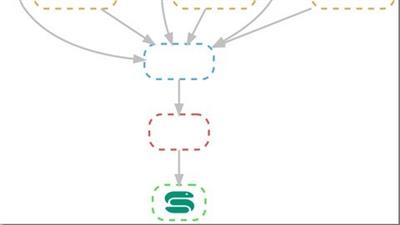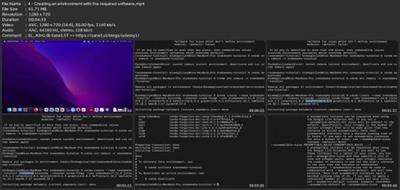O
0

Published 11/2022
MP4 | Video: h264, 1280x720 | Audio: AAC, 44.1 KHz
Language: English | Size: 869.98 MB | Duration: 2h 6m
Bioinformatics workflows for life sciences using snakemake
MP4 | Video: h264, 1280x720 | Audio: AAC, 44.1 KHz
Language: English | Size: 869.98 MB | Duration: 2h 6m
Bioinformatics workflows for life sciences using snakemake
What you'll learn
what is snakemake
install snakemake
build a basic snakemake workflow
understand a snakemake rule, the structure of a rule (input, output, shell, script)
Requirements
Basic UNIX bash shell commands are necessary to follow the course. Everything else will be explained in the course.
Description
Course on snakemake. snakemake is a modern workflow language that is widely used in academic and industrial circles to build reproducible, legible, portable, interoperable and efficient pipelines in bioinformatics and beyond. The course closely follows the basic bioinformatics workflow described in the official snakemake tutorial but takes a step-by-step approach and delves deeply into each feature of the snakemake language. It covers:- installation- Snakefile- rules- directives: input, output, shell, script- target files- creation of a directed acyclic graphThis course does not cover:- benchmarking- conda directive- snakemake profiles for cluster computers- temporary files- parameters- resourcesAt the end of this course, you will be able to build a basic bioinformatics pipeline. This knowledge will be sufficient to make a positive difference in your day-to-day life as a bioinformatician. It will also prepare you for my advanced course on snakemake.The course is primarily intended for bioinformaticians but it can also be useful for people from other fields who want to build pipelines.The course can also be used as an introduction to the field of bioinformatics. In it, I use the concepts of "reads", "alignment", "BAM" files, "VCF" files, variant calls. However, note that I do not spend much time explaining those concepts and focus primarily on the snakemake language.
Overview
Section 1: Introduction
Lecture 1 Introduction
Section 2: Setup
Lecture 2 Installing conda
Lecture 3 Preparing a working directory
Lecture 4 Creating an environment with the required software
Section 3: Basics: an example workflow
Lecture 5 Step 1: Mapping reads without snakemake
Lecture 6 Step 1: my first snakemake rule
Lecture 7 Step 1: snakemake automatically creates the necessary parent directories
Lecture 8 Step 1: rule and directive definitions are indented
Lecture 9 Step 1: when is a target file generated?
Lecture 10 Step 1: brace notation in the shell directive
Lecture 11 Step 2: generalising a snakemake rule to make it work with infinitely many files
Lecture 12 Step 2: list target files in snakemake command
Lecture 13 Step 2: situations in which the snakemake workflow in run
Lecture 14 Step 3: add second snakemake rule
Lecture 15 Step 3: split shell directive command over several lines
Lecture 16 Step 4: add third rule
Lecture 17 Step 4: visualise DAG
Lecture 18 Step 5: named input files
Lecture 19 Step 5: naming input files becomes necessary when there are many of them
Lecture 20 Step 5: aggregate input files with the expand() helper function
Lecture 21 Step 5: aggregate input files over all combinations of variables with expand()
Lecture 22 Step 5: aggregate input files over "zip" combinations of variables with expand()
Lecture 23 Step 6: using custom scripts
Lecture 24 Step 7: adding a target rule
Section 4: Launch a snakemake workflow
Lecture 25 Options to use when launching a snakemake workflow
Section 5: Possible snakemake errors and how to resolve them
Lecture 26 R_LIBS environment variable is set
Lecture 27 bash strict mode
Lecture 28 no config file given
Section 6: Visualise the snakemake workflow
Lecture 29 Rule graph
Bioinformaticians who want to learn how to create clean, efficient and reproducible pipelines.

Download link
rapidgator.net:
You must reply in thread to view hidden text.
uploadgig.com:
You must reply in thread to view hidden text.
nitroflare.com:
You must reply in thread to view hidden text.
1dl.net:
You must reply in thread to view hidden text.

